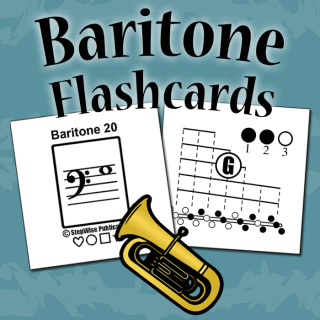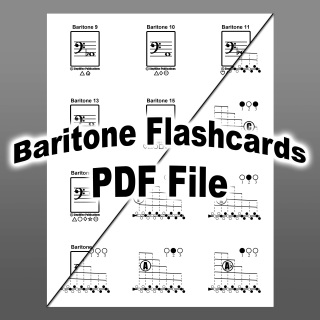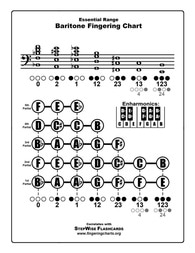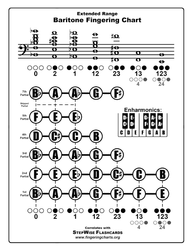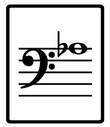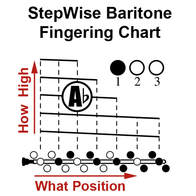How to Play the Baritone/Euphonium - Fingering Chart & Flashcards
Download the Free StepWise Baritone/Euphonium Chart
Essential Range Chart
|
Extended Range Chart
|
Other brass fingering charts do not organize the notes into the overtone series or according to the valve combinations, making it more difficult to make sense of the notes and fingering on the baritone, and how high or low each should be played. This free chart shows young musicians how the notes on the baritone are organized by fingering and partial, making it much easier to memorize them all!
As a bonus, everything fits easily on one page. This allows students in your band to keep this chart on their music stand and use it frequently as a quick reference. I like to print these stepwise fingering charts for my whole band on cardstock and pass them out in the first week of school, along with the fingering flashcards. It is a powerful combination! Download a printable PDF chart by right-clicking one of these links (BC is for Bass Clef, and TC is for Treble Clef). The Extended Range Chart shows an additional 5 notes in the higher register, and both charts show the alternate 4-valve fingerings. | ||||||||
Check out the NinGenius Music App: a super FUN way to learn ALL the notes and fingerings on the baritone/euphonium! |
Check Out the Baritone / Euphonium Flashcards:
|
|
Baritone/euphonium students often learn the first 5 notes of the B-Flat Major Scale very well, but are less confident with many other notes, especially in their extreme upper and lower ranges.
These note & fingering flashcards will help both beginning and more advanced players to learn, memorize, and master every note. You might just be amazed at what great sight readers they become after working with these for a few weeks! Plus, the fingering graphics used for each note helps students better understand how the notes are lined up in the overtone series on the baritone/euphonium. Baritone players who read treble clef (T.C.) should use the Trumpet Flashcards. |
How the Baritone / Euphonium Works: Fingerings, Partials, and NotesThe valve combinations (fingerings) used to play all the notes on the baritone/euphonium are shown along the bottom of each fingering chart, and are organized from shortest (open) to longest (1-2-3), similar to trombone positions. Being able to see this order of valve combinations helps baritone players memorize the fingerings for chromatic motion.
You may notice that the distance between each valve combination is slightly greater than the one before it. This helps explain why some baritones have a 4th valve in order to get the 1-3 and 1-2-3 combinations in tune. (4th valve optional fingerings are shown on all StepWise charts.) One of the coolest things about the StepWise charts is that they show which "partial" each note is on, or how high or low it must be "buzzed". For example, to play the A-flat note shown in the graphics here, you must press the 1st Valve and then buzz the mouthpiece up to the 3rd Partial. Most fingering charts do not show this critical element of playing the right notes on the baritone/euphonium. |

